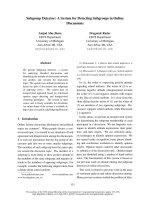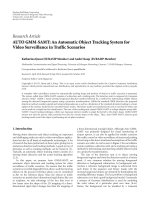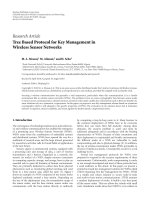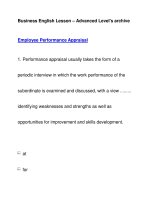THESIS PERFORMANCE APPRAISAL SYSTEM FOR KEY PERSON IN FPT SOFTWARE
Bạn đang xem bản rút gọn của tài liệu. Xem và tải ngay bản đầy đủ của tài liệu tại đây (970.57 KB, 87 trang )
SOLVAY-BRUSSELS SCHOOL OF
ECONOMICS AND MANAGEMENT
NATIONAL ECONOMICS UNIVERSITY
Vietnam – Belgium Master Programmes
MASTERS IN BUSINESS MANAGEMENT
THESIS
PERFORMANCE APPRAISAL SYSTEM FOR KEY PERSON
IN FPT SOFTWARE
Prepared by: Le Anh Tuan
Supervised by: Dr. Vu Tuan Anh
Hanoi 2010
TABLE OF CONTENT
i
EXECUTIVE SUMMARY.................................................................................1
ACKNOWLEDGEMENTS................................................................................2
INTRODUCTION...............................................................................................3
Rationale the research.........................................................................................3
Research objectives.............................................................................................4
Research questions..............................................................................................4
Research methodology........................................................................................4
Scope of research................................................................................................4
The thesis content................................................................................................4
CHAPTER I: LITERATURE REVIEW...........................................................6
I.1 Introduction to performance appraisal system...............................................6
I.1.1 Meaning and definition.............................................................................6
I.1.2 Characteristics of performance appraisal system......................................8
I.2 Objectives of performance appraisal..............................................................9
I.3 Performance appraisal process.....................................................................10
I.4 Factors affecting on employee performance................................................11
I.5 Key elements of performance appraisal system...........................................12
I.5.1 Performance standard.............................................................................12
I.5.2 Performance criteria................................................................................14
I.5.3 Methods for performance appraisal........................................................14
I.5.4 Performance evaluator............................................................................19
I.5.5 Rating errors...........................................................................................21
I.5.6 Performance cycle..................................................................................21
I.5.7 Performance interview............................................................................23
CHAPTER II: FSOFT AT GLANCE..............................................................24
II.1 Fsoft history................................................................................................24
II.2 Organizational chart...................................................................................25
II.3 Financial activities......................................................................................26
II.4 People development....................................................................................28
II.5 HRM context in Fsoft.................................................................................29
II.5.1 Fsoft’s HR principle..............................................................................29
ii
II.5.2 HR practices..........................................................................................30
CHAPTER III: CURRENT PAS IN FSOFT...................................................31
III.1 PAS purpose..............................................................................................31
III.2 Objects of PAS..........................................................................................31
III.3 Performance appraisal standard.................................................................31
III.4 Performance appraisal criteria...................................................................31
III.5 Performance evaluator...............................................................................32
III.6 Performance appraisal method..................................................................32
III.7 Performance appraisal interview...............................................................32
III.8 Performance appraisal period ...................................................................32
CHAPTER IV: RESEACH METHODOLOGY.............................................34
IV.1 Introduction...............................................................................................34
IV.2 Questionnaire.............................................................................................34
IV.3 Data analysis..............................................................................................36
CHAPTER V: FINDINGS AND RECOMMENDATIONS............................52
V.1 Findings......................................................................................................52
V.1.1 Unsatisfactory level of current performance appraisal...........................52
V.1.2 Problems in performance appraisal system............................................52
V.1.3 A few objectives of current performance appraisal system....................53
V.1.4 Evaluating few dimensions of employee performance..........................53
V.1.5 Only one PAS for everyone...................................................................54
V.1.6 No linkage between pay system and PAS..............................................54
V.1.7 Lack of motivated key person................................................................55
V.1.8 Skillful and qualified key person...........................................................55
V.2 Recommendation........................................................................................55
V.2.1 Build separate performance appraisal system for key person................56
V.2.2 Improving training program...................................................................58
V.2.3 Improving incentive and reward system................................................58
V.2.4 Improving motivation............................................................................59
V.2.5 Enhancing ability...................................................................................61
V.2.6 Reviewing and controlling rating system regularly...............................61
iii
CONCLUSION..................................................................................................62
REFERRENCE....................................................................................................i
APPENDICES.....................................................................................................ii
Part A: Survey questionnaire...............................................................................ii
Part B: Research result.......................................................................................vi
1. Respondent structure....................................................................................vi
2. Satisfactory level of current performance appraisal system.........................vi
3. Consensus level of current performance appraisal system...........................vi
4. Knowledge..................................................................................................vii
5. Number of years working experience.........................................................vii
6. Project management level...........................................................................vii
7. Skills and competencies.............................................................................viii
8. Motivation.................................................................................................viii
........................................................................................................................... viii
Part C: Performance appraisal form...................................................................ix
iv
LIST OF TABLES
v
Table 1: Comparison between performance management and PA..................8
Table 2: Fsoft's history......................................................................................25
Table 3: Fairness statement..............................................................................38
Table 4: Criteria statement...............................................................................38
Table 5: Method statement...............................................................................39
Table 6: Linkage statement...............................................................................39
Table 7: Education level....................................................................................40
Table 8: Professional training and certificates................................................40
Table 9: Level of foreign language proficiency................................................41
Table 10: Software development method.........................................................41
Table 11: Software development process.........................................................41
Table 12: Leadership skill.................................................................................42
Table 13: Negotiation skill................................................................................42
Table 14: Communication skill.........................................................................43
Table 15: Team building/development skill.....................................................43
Table 16: Client management skill...................................................................43
Table 17: Analysis and problem solving skill...................................................44
Table 18: Conflict resolution skill.....................................................................44
Table 19: Project scope management skill.......................................................45
Table 20: Project time management skill.........................................................45
Table 21: Project cost management skill..........................................................45
Table 22: Project quality management skill....................................................46
Table 23: Project human resource management skill.....................................46
Table 24: Project risk management skill..........................................................46
Table 25: Project procurement management skill..........................................47
Table 26: Breadth (not depth) in specific application/industry knowledge
skill.....................................................................................................................47
Table 27: Life cycle management skill.............................................................48
Table 28: Years of working experience............................................................48
Table 29: Project management level................................................................48
Table 30: Important level of responsibility motivation...................................49
vi
Table 31: Important level of sense of accomplishment motivation................49
Table 32: Important level of opportunity to grow motivation........................49
Table 33: Important level of incentive motivation..........................................50
Table 34: Important level of promotion motivation........................................50
Table 35: Important level of power motivation...............................................51
Table 36: Important level of praise motivation...............................................51
Table 37: Important level of affiliation motivation.........................................51
Table 38: Summary of level of importance of motivation..............................60
LIST OF FIGURES
Figure 1: Performance appraisal process........................................................10
Figure 2: Maslow's Hierarchy of needs...........................................................12
Figure 3: Term used to define standards at one company..............................13
Figure 4: 360-degree feedback..........................................................................18
Figure 5: Traditional review process by which supervisors conduct PA.......19
Figure 6: Person being appraised in 360 degree feedback.............................21
Figure 7: Fsoft organizational chart................................................................26
Figure 8: Market contribution to Fsoft revenue.............................................27
Figure 9: Fsoft revenue (2005-2011).................................................................27
Figure 10: Highlighted financial figure (2005-2008).......................................28
Figure 11: Fsoft human resource (2004-2009).................................................28
Figure 12: "Fsoft structure with Customer" HRM principle........................29
Figure 13: Gender breakdown..........................................................................36
Figure 14: Age breakdown................................................................................37
Figure 15: Working status breakdown.............................................................37
Figure 16: Satisfactory level of current PAS...................................................37
Figure 17: Core competency areas...................................................................56
vii
LIST OF ABBREVIATIONS
HR
HRM
PMS
PAS
SKA
MBO
TQM
FSOFT
ERP
IT
CMMI
GMAT
TOEFL
ISO
BARS
TOEIC
ICT
OSDC
IQ
EU
US
SRU
HC
HO
OB
DB
OG
BS
CHE
Human Resource
Human Resource Management
Performance Management System
Performance Appraisal System
Skills, Knowledge and Abilities
Management By Objectives
Total Quality Management
FPT Software
Enterprise Resource Planning
Information Technology
Capability Maturity Model Integration
Graduate Management Admission Test
Test of English as Foreign Language
International Organization for Standardization
Behaviourally Anchored Rating Scales
Test of English for International Communication
Information Communication Technology
Offshore Software Development Center
Intelligence Quotient
European Union
United State
Strategic Resource Unit
Human Capital
Head Office
Oversea Branch
Domestic Branch
Operation Group
British Standard
Performance appraisal in FPT software
viii
EXECUTIVE SUMMARY
Performance appraisal may be understood as the assessment of an individual's
performance in a systematic way. It plays very important role in HR activities for
any company in any industry. The performance appraisal is important to
employees’ professional development, to meeting the company’s goals or
objectives and, ultimately, to contributing to the company’s bottom line. Good
performance appraisal system leads to motivate employees, increase productivity,
stabilize organizational structure.
In Fsoft, key person – project manager and leader accounts for 26% of total staff.
They are the key success factors in the IT outsourcing projects as well as for the
development of Fsoft. Currently, turnover rate for key person is extremely high,
at 19%. The high turnover rate can cause some problems such as unstable
structure, de-motivation for remaining staff, low productivity, costing in term of
training and nurturing the potential key person.
This paper is to aim to review current performance appraisal system – CHE and
propose new performance appraisal system for key person in FPT software. The
theoretical background of performance appraisal system and theory of (McCloy,
R. A., Campbell, J. B. and Cudeck, R., 1994) that employee performance is
affected by knowledge, skills, abilities and motivations is used for this reviewing
and making proposal. At the first stage of this proposal, based on company
profile, HR statistics, and personal experience, whole picture of current
performance appraisal system is drawn.
In the next step, based on factors affecting on performance, survey questionnaire
is created to investigate feedback of key person on CHE and those factors. With
the data collected from survey and the mapping with theoretical base, problems
and expectations of performance evaluation system from key person are made
up.
With this result, the thesis proposes new performance appraisal system for key
person in FPT software and other recommended tactics to improve key person
performance.
Keywords: performance appraisal, project manager, employee performance,
ability, skill, knowledge, motivation, FPT software.
1
ACKNOWLEDGEMENTS
This dissertation was completed as a partial requirement for fulfillment of degree
at Vietnam – French Community of Belgium Master Programs.
First, I would like express my sincere gratitude to MBA Vu Tuan Anh, my
academic supervisor for his guidance, advice and comments during the whole
process of thesis writing
Furthermore, I also thank the faculty members of Université Libre de Bruxelles
and National Economics University, Deans, Professors, Executives and Teachers
for their supports. They all gave me the honor of attaining such a great program.
I also very appreciate management of Fsoft, especially for HR department for
their enthusiastic and valuable support.
Finally, I am grateful to all family members, and my MBM7 group mates who in
many ways contributed and supported me. My heartfelt thank is especially for
my wife, Thao, for her encouragement and supports in not only this thesis
process but also the last two year course.
2
INTRODUCTION
Rationale the research
Nowadays, IT outsourcing service plays more and more important roles in global
economy. Global IT outsourcing market is growing very fast in the recent years
with growth rate about 50% and expected rate in next few years at 70%. In
Vietnam, the economic booming and dramatic growth of international trade bring
very high demands for IT outsourcing industry. This demand leads to open many
IT outsourcing companies and increase competitiveness in this industry.
Being in Vietnam for more than 13 years, FPT Software - the leading IT
outsourcing company, has been attaining many excellent achievements and
certificated partnerships with famous corporate in the world. Now FPT Software
has 2600 staff, with branches in Japanese, Singapore, France, Malaysia, Australia
and America. Revenue in 2008 is 42 millions USD contributed significantly from
Japanese, Asia pacific and EU market.
With characteristics of team-based structure, Fsoft has divided into development
centers responsible for some accounts or some markets. Each center is composed
of divisions of some accounts or one market. For specific project, Fsoft divides
teams into small teams with 5-7 members. One small team has one leader. One
big team has one manager So on average, those leaders and managers
(hereinafter we called key person) in Fsoft make up 26 percents of total staff.
They are core persons and are one of the most key success factors for the project
as well as for development of Fsoft.
According to HRM system in Fsoft, turnover rate for key person is extremely
high, at 19%. It means that five key persons join into company; one key person is
going out. The high turnover rate can cause some problems such as unstable
structure, de-motivation for remaining staff, low productivity, costing in term of
training and nurturing the potential key person.
CHE – Performance appraisal system in Fsoft was built in 2000. After ten years,
CHE and HRM are facing with following problems:
− Talent goes, bad fires and middle remains
− Middle remaining works with low productivity & de-motivated
− Projects maybe fails therefore company might be lost of customer,
profit…
- Company goes in not cost-effective way (training cost for project manager
is very high)
This situation requires Fsoft to review performance appraisal system for
necessary adjustments to solve those problems. That is purpose to choose this
topic for my thesis.
3
Research objectives
The study has three objectives:
− Review the fundamental background of performance management and
performance appraisal system that are applicable the practical business.
− Evaluate current performance appraisal system based on theories and data
from primary survey.
− Propose recommendations for Fsoft to build performance appraisal system
for key person.
Research questions
This research will answer the following questions:
1. What are existing performance appraisal systems in Fsoft?
2. What are the competencies and feedback of key persons toward the
existing system?
3. What is the most suitable performance appraisal system for key person?
Research methodology
Secondary data includes statistic information about key person as turnover rate,
productivities, existing performance appraisal system and some papers of
performance appraisal system.
Primary data is the survey (both current employees and people left companies).
This questionnaire of survey is designed based on research problem and
theoretical basic.
Scope of research
The research only focuses on building separate performance appraisal system for
key person in Fsoft from year 2000 (when CHE was built) up to now with
assumptions: Clear job analysis and description, clear communicating job
analysis and description, not relating to company strategies and very good
company culture.
Based on theoretical base of performance appraisal and with collected secondary
survey and primary data, the study will propose performance appraisal system for
key person and then identify some next moves in applying this rating system into
Fsoft.
The thesis content
Introduction
Chapter I: Literature review
The first chapter illustrates the fundamental background of the study like key
concepts, characteristics and basic elements of PAS.
Chapter II: FPT Software at glance
This chapter introduces Fsoft in some aspects such as history, strategy, structure and
4
highlighted figure to help readers understand the overview context of the study.
Chapter III: Current performance appraisal system in Fsoft
The third chapter describes the existing rating system in Fsoft in all aspects
mentioned in literature review chapter.
Chapter IV: Research methodology
The fourth chapter focuses on primary data to investigate feedback, expectation
of key persons about the new performance appraisal system as well as their
competencies toward new system.
Chapter V: Findings and recommendations
The last chapter encloses with findings of the study and recommendations for HR
department and top management to build a separate performance appraisal
system for key person.
Conclusion
5
CHAPTER I: LITERATURE REVIEW
The first chapter illustrates the fundamental background of the study. It will start
by introducing performance appraisal system with some key concepts such as
performance, performance appraisal and differences between performance
appraisal and performance management. The chapter also introduces the
characteristics of performance appraisal and its purposes. The chapter ends with
the key elements of performance appraisal system.
I.1 Introduction to performance appraisal system
I.1.1 Meaning and definition
What is performance?
There are different views on what performance is. It can be regarded as simply
the record of outcomes achieved (Armstrong, 2000). On an individual basis, it is
a record of person’s accomplishments. The Oxford English Dictionary defines
performance as the accomplishment, execution, carrying out, and working out of
anything ordered or undertaken. This refers to outputs/outcomes
(accomplishment) but also states that performance is about doing the work as
well as being about the results achieved. Performance could therefore be
regarded as behaviour the way in which organizations, teams and individuals get
work done (Armstrong, 2000).
Brumbach defines performance as embracing both behaviour and outcomes in a
more comprehensive view:
“Performance means both behaviours and results. Behaviours emanate from the
performer and transform performance from abstraction to action. Not just the
instruments for results, behaviours are also outcomes in their own right the
product of mental and physical effort applied to tasks and can be judged apart
from results.” (Brumbach, 1988)
What is performance management?
Waldt defines performance management as the shared process: “In essence,
performance management is a shared process between managers and the
individuals and teams they manage. It is based on the principle of management
by contract rather than command, although this does not exclude the need to
incorporate high performance expectations in such contracts.” (Waldt, 2004)
A clear definition of performance managemnet is provided by Micheal
Armstrong:
“Performance management is a means of getting better results from the
6
organization, teams and individuals by understanding and managing
performance within an agreed framework of planned goals, objectives and
standards.” (Armstrong, 2000).
Performance management, then, is a systematic approach to the management of
people ensuring that:
-
A shared vision of the organization and its objectives is communicated
clearly by top management
Individual goals are agreed that take into account wider organizational
goals
Regular feedback and reviews of progress are held
The review process identifies training, development and reward outcomes
The system is driven by line management
The effectiveness of the whole process is regularly evaluated
Therefore, performance management relies on the establishment of clear, realistic
performance goals between the line manager and employees. The employee
objectives may be expressed in terms of targets, standards of performance or
tasks to be completed.
What is performance appraisal?
In simple terms, performance appraisal may be understood as the assessment of
an individual's performance in a systematic way, the performance being
measured against such factors as job knowledge, quality and quantity of output,
initiative, leadership abilities, supervision, dependability, co-operation, judgment,
versatility, health, and the like. Assessment should not be confined to past
performance alone. Potentials of the employee for future performance must also
be assessed. (Aswathappa, 2007)
A formal definition of performance appraisal is:
“It is the systematic evaluation of the individual with respect to his or her
performance on the job and his or her potential for development.”
A more comprehensive definition is:
“Performance' appraisal is a formal structured system of measuring and
evaluating an employee’s job related behaviors and outcomes to discover how
and why the employee is presently performing on the job and how the employee
can perform more effectively in the future so that the employee organization and
society all benefit.” (Aswathappa, 2007)
Difference between performance appraisal and performance management
For many years, the focus for performance evaluation was the system built
around performance appraisal. Increasingly, though, the establishment of more
comprehensive systems of performance management is taking root in
organizations as a mean of measuring individual effectiveness. Appraisal systems
7
form a part of this – often, still, a central part.
Table below outlines the difference between performance management and
performance appraisal:
Table 1: Comparison between performance management and PA
Performance management
Performance should be managed throughout
the year, not just at the annual appraisal
Performance management looks forward
Done for good of department and individual
Done in line with organization’s objectives
and strategy
Performance appraisal
Done once a year with six
monthly/quarterly reviews (not always
done)
Review past performance – makes targets
for future (not always done)
Often done to appease human resource
department – individual suffers if done by
untrained line manager
Organization’s objective and strategy are
not always taken into consideration
I.1.2 Characteristics of performance appraisal system
Performance appraisal cannot be implemented successfully unless it is accepted
by all concerned. Some of the important considerations in designing a
performance appraisal system are:
− First, they are formal systems with a set of rules and guidelines that must be
followed in their operation. For example, the time between appraisals will
usually be laid down. It might take place every six months, at yearly intervals,
or occasionally even less frequently. The position of the person who is to
carry out the appraisal will also be specified. Up until recently, this was
usually the appraisee’s immediate superior, but as we shall see later,
increasingly others are being brought into the process. What is to be appraised
is also determined in advance.
− Another feature of many appraisal systems is the requirement to provide a
comprehensive assessment of all relevant aspects of performance. The
information collected is recorded in some form, either as a written report, or
in the form of ratings of individual aspects of performance.
− The purposes of the appraisal system and consequently the outcomes to be
expected from it are usually made explicit to both the appraiser and the
appraisee. Thus, for example, if pay rises are to be based on appraisal data,
then this should be known up front to all concerned. Similarly, if one of the
purposes of an appraisal system is to establish training and development
needs, then the appraisee should be aware that this is the case.
− The basis of the typical performance appraisal system is a review of past
performance, usually covering the period since the previous appraisal. Often
there will be a direct comparison with the results from the previous year’s
appraisal.
− In most cases, there will be feedback to the appraisee on how he or she has
8
been assessed. This is most often done in the context of an appraisal
interview. The interview will typically include a discussion not only of past
performance, but also of what needs to be done to improve performance in
the future.
I.2 Objectives of performance appraisal
Data relating to performance assessment of employees are recorded, stored, and
used for several purposes. There are two important objectives: developmental
uses and administrative uses/decisions.
Development uses
Performance appraisal can be a primary source of information and feedback for
employees, which is the key to their future development. When supervisors
identify the weaknesses, potentials, and training needs of employees through
performance appraisal feedback, they can inform employees about their progress,
discuss what skills they need to develop, and work out development plans.
The manager’s role in such a situation is like that of a coach. The coach’s job is
to reward good performance with recognition, explain what improvement is
necessary, and show employees how to improve. After all, people do not always
know where they could improve, and managers really cannot expect
improvement if they are unwilling to explain where and how improvement can
occur.
The purpose of developmental feedback is to change or reinforce individual
behavior, rather than to compare individuals - as in the case of administrative
uses of performance appraisal. Positive reinforcement for the behaviors the
organization wants is an important part of development.
The use of teams provides a different set of circumstances for developmental
appraisal. The manager may not see all of the employee’s work, but team
members do. Teams can provide developmental feedback. However, it is still an
open question whether teams can handle administrative appraisal. When teams
are allowed to design appraisal systems, they prefer to “get rid of judgment,” and
they apparently have a very hard time dealing with differential rewards. Perhaps,
then, group appraisal is best used for developmental purposes.
Administrative uses
A performance appraisal system is often the link between the rewards employees
hope to receive and their productivity. The linkage can be thought of as follows:
Productivity → performance appraisal → rewards
Compensation based on performance appraisal is at the heart of the idea that
raises should be given for performance accomplishments rather than for seniority.
Under performance-oriented systems, employees receive raises based on how
well they perform their jobs. The manager’s role historically has been as an
9
evaluator of a subordinate’s performance, which then leads to managers making
compensation recommendations or decisions for employees. If any part of the
process fails, the most productive employees do not receive the larger rewards,
resulting in perceived inequity in compensation.
I.3 Performance appraisal process
Figure 1: Performance appraisal process
Objectives of appraisal
The first step is to identify objectives for performance appraisal system. The
objectives might be the ones in the section I.2.
Establish job expectation
The second step in the appraisal process is to establish job expectations. This
includes informing the employee what is expected of him or her on the job.
Normally, a discussion is held with his or her superior to review the major duties
contained in the job place of formal performance evaluation.
Design an appraisal performance
Designing an appraisal programme poses several questions that need to answers:
1.
2.
3.
4.
5.
6.
7.
Formals versus informal appraisal
Whose performance is to be assessed?
Who are the raters?
What problems are encountered?
How to solve the problems?
What should be evaluated?
When to evaluate?
10
8. What methods of appraisal are to be used?
Performance interview
Performance interview is another step in the appraisal process that will describe
more details in the section I.4.7.
Use appraisal data for appropriate purposes
The final step in the evaluation process is the use of evaluation data. The data and
information generated through performance evaluation must be used by the HR
department.
In one way or another, data and information outputs of a performance appraisal
system can be useful in the following areas of HRM:
−
−
−
−
−
−
Remuneration administration
Validation of selection programmes
Employee training and development programmes
Promotion, transfer and lay-off decisions
Grievance and discipline programmes
HR planning
I.4 Factors affecting on employee performance
Studies (McCloy, R. A., Campbell, J. B. and Cudeck, R., 1994) show that
employee performance depends on the following general factors:
Employee performance = f (K, S, A, M) where:
* K = Knowledge of facts, rules, principles, and procedures
* S = Skills to handle tasks
* A = Abilities to perform tasks
* M = Motivation to perform
Employee performance depends upon some blend of knowledge, skill, ability,
and motivation. People with in-depth knowledge (K) need to be hired. It is also
necessary to concentrate on building skills (S) and abilities (A), and to find ways
to motivate (M) employees to perform in ways that contribute to higher
individual and organizational performance. For an organization to succeed, it
needs employees who perform well. This involves not only good compensation
strategy and practice, but other well-developed human resource policies as well.
Motivation is the activation or energization of goal-oriented behavior. Motivation
is said to be intrinsic or extrinsic. Intrinsic motivation comes from rewards
11
inherent to a task or activity itself - the enjoyment of a puzzle or the love of
playing. Social and educational psychologists have studied this form of
motivation since the early 1970s. Research has found that it is usually associated
with high educational achievement and enjoyment by students. Extrinsic
motivation comes from outside of the performer. Money is the most obvious
example, but coercion and threat of punishment are also common extrinsic
motivations.
The basis of Maslow's theory of motivation (Maslow, 1954) is that human beings
are motivated by unsatisfied needs, and that certain lower needs need to be
satisfied before higher needs can be addressed. Per the teachings of Abraham
Maslow, there are general needs (physiological, safety, love, and esteem) which
have to be fulfilled before a person is able to act unselfishly. These needs were
dubbed "deficiency needs." While a person is motivated to fulfill these basal
desires, they continue to move toward growth, and eventually self-actualization.
The satisfaction of these needs is quite healthy. While preventing their
gratification makes us ill or act evilly.
Figure 2: Maslow's Hierarchy of needs
As a result, for adequate workplace motivation, it is important that leader
understands which needs are active for individual employee motivation. In this
regard, Abraham Maslow's model indicates that basic, low-level needs such as
physiological requirements and safety must be satisfied before higher-level needs
such as self-fulfillment are pursued. As depicted in this hierarchical diagram,
sometimes called 'Maslow's Needs Pyramid' or 'Maslow's Needs Triangle', when
a need is satisfied it no longer motivates and the next higher need takes its place.
I.5 Key elements of performance appraisal system
I.5.1 Performance standard
12
To know that an employee produces 10 "photons" per day does not provide a
complete basis for judging employee performance as satisfactory or not. Maybe
15 photons are considered a sufficient day's work. Performance standards define
the expected levels of performance, and are "benchmarks,” or goals,” or “targets"
- depending on the approach taken. In a sense, performance standards define
what satisfactory job performance is. It is important to establish standards before
the work is performed, so that all involved will understand the level of
accomplishment expected. When standards and goals are set, organization has to
communicate the standards and goals in detail to all employees. Because when he
employee understands the goals and standards, it is easier to point out why they
earned a certain score in a given criteria.
The extent to which standards have been met often is expressed in either
numerical or verbal ratings, for example, "outstanding" or "unsatisfactory". It
may sometimes be difficult for two or more people to reach agreement on exactly
what the level of performance has been relative to the standard. Figure 2 show
terms used in evaluating employee performance on standards at one company.
Notice that each level is defined in terms of performance standards, rather than
numbers, in order to minimize different interpretations of the standards. Sales
quotas and production output standards are familiar numerical performance
standards. A non-numerical standard of performance is that a sales man must
communicate well with his customers.
Figure 3: Term used to define standards at one company
Someone external to the job, such as a supervisor or a quality control inspector,
often sets standards but employees can write them effectively as well.
Experienced employees usually know what constitutes satisfactory performance
of tasks in their job descriptions, and so do their supervisors. Therefore, these
13
individuals often can collaborate effectively on setting standards.
I.5.2 Performance criteria
It is not difficult for all employees to agree that performance appraisal is
necessary in human resource management. The question is about what exactly
are measured or assessed. There are various criteria including SKAs, personal
traits, work behaviours and results (Milkovich & Boudreau, 1991). SKAs
normally come with the employees upon their employment. Professional like
doctors, lawyers or accountants must have obtained their professional
qualifications before working in such professions.
Traits
Traits are basically referred to the desirable characteristics like loyalty, initiative,
and intelligence, trustworthy, kind, cheerful, brave or friendly. These
characteristics fit all jobs. They are not related to organizational goals.
Competencies
In the recent years, there has been a growth of using competency-based appraisal.
Competency, as defined by (Boyatzis, 1982) is “an underlying characteristic of a
person,” which could be “a motive, trait, skill, aspect of one’s self-image or
social role, or a body of knowledge which he or she uses.” Others describe what
constitutes competence: “an observable skill or ability to complete a managerial
task successfully” (Jacobs, 1989) while (Woodruffe, 1990) writes about
“behavioural dimensions that affect job performance”.
Behaviours and results
Behaviours and results are the bases for the two most objective appraisals:
behaviourally-anchored rating scales (BARS) and management by objectives
(MBO). Behaviours are the activities and tasks that individuals are engaged
during the course of duty while results are the outcome of these activities.
Behaviours and result are observable and are more objective
I.5.3 Methods for performance appraisal
Traditional methods of performance appraisal
Essay appraisal method
This traditional form of appraisal, also known as “Free Form method” involves a
description of the performance of an employee by his superior. The description is
an evaluation of the performance of any individual based on the facts and often
includes examples and evidences to support the information. A major drawback
of the method is the inseparability of the bias of the evaluator.
Straight ranking method
14
This is one of the oldest and simplest techniques of performance appraisal. In this
method, the appraiser ranks the employees from the best to the poorest based on
their overall performance. It is quite useful for a comparative evaluation.
Paired comparison
A better technique of comparison than the straight ranking method, this method
compares each employee with all others in the group, one at a time. After all the
comparisons based on the overall comparisons, the employees are given the final
rankings.
Critical incident methods
In this method of performance appraisal, the evaluator rates the employee based
on critical events and how the employee behaved during those incidents. It
includes both negative and positive points. The drawback of this method is that
the supervisor has to note down the critical incidents and the employee behaviour
as and when they occur.
Field review
In this method, a senior member of the HR department or a training officer
discusses and interviews the supervisors to evaluate and rate their respective
subordinates. A major drawback of this method is that it is a very time consuming
method. But this method helps to reduce the superiors’ personal bias.
Checklist method
The rater is given a checklist of the descriptions of the behaviour of the
employees on job. The checklist contains a list of statements based on which the
rater describes the on the job performance of the employees.
Graphic rating scale
In this method, an employee’s quality and quantity of work is assessed in a
graphic scale indicating different degrees of a particular trait. The factors taken
into consideration include both the personal characteristics and characteristics
related to the on-the-job performance of the employees. For example, a trait like
Job Knowledge may be judged on the range of average, above average,
outstanding or unsatisfactory.
Forced distribution
To eliminate the element of bias from the rater’s ratings, the evaluator is asked to
distribute the employees in some fixed categories of ratings like on a normal
distribution curve. The rater chooses the appropriate fit for the categories on his
own discretion.
Modern methods for performance appraisal
Assessment centers
15
An assessment centre typically involves the use of methods like social/informal
events, tests and exercises, assignments being given to a group of employees to
assess their competencies to take higher responsibilities in the future. Generally,
employees are given an assignment similar to the job they would be expected to
perform if promoted. The trained evaluators observe and evaluate employees as
they perform the assigned jobs and are evaluated on job related characteristics.
The major competencies that are judged in assessment centers are interpersonal
skills, intellectual capability, planning and organizing capabilities, motivation,
career orientation etc. assessment centers are also an effective way to determine
the training and development needs of the targeted employees.
Behaviorally anchored rating scales
Behaviorally Anchored Rating Scales (BARS) is a relatively new technique that
combines the graphic rating scale and critical incidents method. It consists of
predetermined critical areas of job performance or sets of behavioral statements
describing important job performance qualities as good or bad (for example, the
qualities like inter-personal relationships, adaptability and reliability, job
knowledge etc). These statements are developed from critical incidents.
In this method, an employee’s actual job behaviour is judged against the desired
behaviour by recording and comparing the behaviour with BARS. Developing
and practicing BARS requires expert knowledge.
Human resource accounting method
Human resources are valuable assets for every organization. Human resource
accounting method tries to find the relative worth of these assets in the terms of
money. In this method, the performance appraisal of the employees is judged in
terms of cost and contribution of the employees. The cost of employees include
all the expenses incurred on them like their compensation, recruitment and
selection costs, induction and training costs etc whereas their contribution
includes the total value added (in monetary terms). The difference between the
cost and the contribution will be the performance of the employees. Ideally, the
contribution of the employees should be greater than the cost incurred on them.
Management by objectives
MBO represents a modern method of evaluating the performance of personnel.
Thoughtful managers have become increasingly aware that the traditional
performance evaluation systems are characterized by somewhat antagonistic
judgments on the part of the rater. There is a growing feeling nowadays that it is
better to make the superior work with subordinates in fixing goals. This would
inevitably enable subordinates to exercise self-control over their performance
behaviors. The concept of management by objectives is actually the outcome of
the pioneering works of Drucker (1954), McGregor (1957), and Odiorne (1965)
in management science. Management by objectives can be described as “a
16









